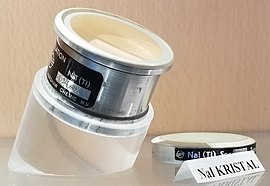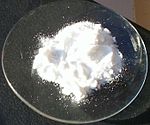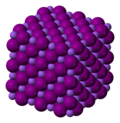
Back يوديد الصوديوم Arabic سودیوم یودیود AZB সোডিয়াম আয়োডাইড Bengali/Bangla Natrij-jodid BS Iodur de sodi Catalan Jodid sodný Czech Natriumiodid German Ιωδιούχο νάτριο Greek Natria jodido Esperanto Yoduro de sodio Spanish
| |||
 NaI(Tl) scintillators
| |||
| Identifiers | |||
|---|---|---|---|
| |||
3D model (JSmol)
|
|||
| ChEBI | |||
| ChEMBL | |||
| ChemSpider | |||
| ECHA InfoCard | 100.028.800 | ||
PubChem CID
|
|||
| RTECS number |
| ||
| UNII | |||
CompTox Dashboard (EPA)
|
|||
| |||
| |||
| Properties | |||
| NaI | |||
| Molar mass | 149.894[1] | ||
| Appearance | white solid deliquescent[1] | ||
| Odor | odorless | ||
| Density | 3.67 g cm−3[1] | ||
| Melting point | 661 °C (1,222 °F; 934 K)[1] | ||
| Boiling point | 1,304 °C (2,379 °F; 1,577 K)[1] | ||
| 1587 g/L (0 °C) 1842 g/L (25 °C) 2278 g/L (50 °C) 2940 g/L (70 °C) 3020 g/L (100 °C)[2][3] | |||
| Solubility | ethanol, acetone[1] | ||
| Band gap | 5.89 eV[4][5] | ||
| −57×10−6 cm3 mol−1[6] | |||
Refractive index (nD)
|
1.93 (300 nm) 1.774 (589 nm) 1.71 (10 μm)[7] | ||
| Structure[8] | |||
| Halite, cF8 | |||
| Fm3m, No. 225 | |||
a = 0.6462 nm
| |||
Formula units (Z)
|
4 | ||
| Octahedral | |||
| Thermochemistry[9] | |||
Heat capacity (C)
|
52.1 J mol−1 K−1 | ||
Std molar
entropy (S⦵298) |
98.5 J mol−1 K−1 | ||
Std enthalpy of
formation (ΔfH⦵298) |
−287.8 kJ mol−1 | ||
Gibbs free energy (ΔfG⦵)
|
−286.1 kJ mol−1 | ||
| Hazards | |||
| Occupational safety and health (OHS/OSH): | |||
Main hazards
|
Irritant, can harm the unborn child | ||
| GHS labelling: | |||
 
| |||
| Danger | |||
| H315, H319, H400 | |||
| P273, P305+P351+P338[10] | |||
| NFPA 704 (fire diamond) | |||
| Flash point | Non-flammable | ||
| Safety data sheet (SDS) | [1] | ||
| Related compounds | |||
Other anions
|
Sodium fluoride Sodium chloride Sodium bromide Sodium astatide | ||
Other cations
|
Lithium iodide Potassium iodide Rubidium iodide Caesium iodide Francium iodide | ||
Except where otherwise noted, data are given for materials in their standard state (at 25 °C [77 °F], 100 kPa).
| |||
Sodium iodide (chemical formula NaI) is an ionic compound formed from the chemical reaction of sodium metal and iodine. Under standard conditions, it is a white, water-soluble solid comprising a 1:1 mix of sodium cations (Na+) and iodide anions (I−) in a crystal lattice. It is used mainly as a nutritional supplement and in organic chemistry. It is produced industrially as the salt formed when acidic iodides react with sodium hydroxide.[11] It is a chaotropic salt.
- ^ a b c d e f Haynes, p. 4.86
- ^ Seidell, Atherton (1919). Solubilities of inorganic and organic compounds c. 2. D. Van Nostrand Company. p. 655.
- ^ Haynes, p. 5.171
- ^ Miyata, Takeo (1969). "Exciton Structure of NaI and NaBr". Journal of the Physical Society of Japan. 27 (1): 266. Bibcode:1969JPSJ...27..266M. doi:10.1143/JPSJ.27.266.
- ^ Guizzetti, G.; Nosenzo, L.; Reguzzoni, E. (1977). "Optical properties and electronic structure of alkali halides by thermoreflectivity". Physical Review B. 15 (12): 5921–5926. Bibcode:1977PhRvB..15.5921G. doi:10.1103/PhysRevB.15.5921.
- ^ Haynes, p. 4.130
- ^ Haynes, p. 10.250
- ^ Davey, Wheeler P. (1923). "Precision Measurements of Crystals of the Alkali Halides". Physical Review. 21 (2): 143–161. Bibcode:1923PhRv...21..143D. doi:10.1103/PhysRev.21.143.
- ^ Haynes, p. 5.36
- ^ "Sodium iodide 383112". Sigma Aldrich.
- ^ Cite error: The named reference
Ullmannwas invoked but never defined (see the help page).


